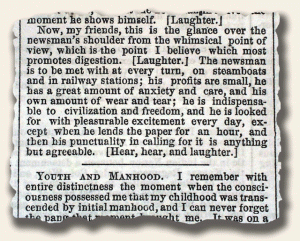The Civil War…
April 1, 2010 by GuyHeilenman · Leave a Comment
 Not too long ago we had a collector ask several questions regarding rare newspapers from the Civil War. We thought others might be interested in the questions and responses as well.
Not too long ago we had a collector ask several questions regarding rare newspapers from the Civil War. We thought others might be interested in the questions and responses as well.
Most major city papers had a daily and bi-weekly edition, and some a tri-weekly edition. The cost of a newspaper from the pre-1890 era was no small expense, so the latter two were more affordable for many. I suspect the “Evening Edition” did not publish 7 days a week; perhaps 2 or 3, maybe 4 (?). If this was the case it was easy for them to fill in the balance of the issue with news from a day or two before as the type was already set and those who purchased it hadn’t read it. This was more clearly defined with the Phila. Inq. run we had because they had in the first column that it was the “tri-weekly” edition, and in the same issue was another masthead from the day before. The Tribune did not print such a notice, or at least I haven’t found it yet.
And such editions with 2 masthead are quite uncommon because libraries would have only subscribed to the regular daily edition, given their desire to document all news for every day, and 95% of early newspapers on the market came from some institution after microfilming. So the 2 masthead issues are typically only found as never-bound issues which have survived the years in attics, trunks, etc.
Thanks for the member inquiry which led to these responses from Tim. Feel free to send your questions, comments as well.
19th century newspapers… revisited…
December 26, 2009 by GuyHeilenman · 1 Comment
Over the past three weeks Timothy Hughes has explored his thoughts concerning what he believes to be the top ten newspapers from each of the pre-18th, 18th, and 19 centuries (see below), the most recent being the latter. Some of his thoughts concerning the 1800’s historic newspapers were captured in the following video:
Collecting authentic rare and historic newspapers from the 1800’s can be exciting, rewarding and surprisingly affordable. Daily newspaper reports of America’s tumultuous 19th Century included first hand accounts of historic turning-points like….. the Louisiana Purchase…the Civil War…and Spanish-American conflict. As cries of “manifest destiny” signaled America’s unbridled expansion west, newspapers became a crucial link for a people suddenly united in a common quest that would set their young nation on a course of unprecedented and historic prosperity.
There are many sought after “holy grails” from the 19th century, including: o President Abraham Lincoln’s Assassination o Battle of Gettysburg and the Gettysburg Address o Battle of the Alamo o Deaths of Jessie James and Billy the Kid o Issue from Tombstone Arizona (Tombstone Epitaph) o Winslow Homer’s “Snap the Whip”
Of course, select accounts of the most historic & desired events of 19th century America are available for premium prices.
However, a wealth of fascinating original newspapers from the vast inventory of Timothy Hughes Rare & Early Newspapers are available for much less…often as little as $30 – $50. These include first-hand news from the War of 1812, Yankee & Confederate Civil War battle reports, slave ads from the South, the California Gold Rush with outlaw & Indian battle accounts, the Mormon migration to Utah and fascinating reports of when baseball was in its infancy.
The “Old West” and America’s westward expansion are represented in genuine newspapers from California, Utah, Nevada, Montana, and Arizona. You’ll also find affordable issues from the illustrated press which graphically documented every aspect of 19th century America in the pages of Harper’s Weekly, Frank Leslie’s Illustrated, Gleason’s, Ballou’s, and The London Illustrated News.
Whether your interest is in the War of 1812, westward expansion and the gold rush, the Civil War, and/or the Wild West, original newspapers provide an excellent view of history in context. History is never more fascinating than when when it’s read from the day it was first reported. If you love history… you deserve to have it in your hands. Rare newspapers make this possible. Please enjoy the hobby.
Top ten newspapers: 16th and 17th centuries…
Top ten newspapers: 18th century…
Top ten newspapers: 19th century…
“News Rooms”: a curiosity of the past…
September 21, 2009 by TimHughes · Leave a Comment
One last excerpt from Clarence Brigham’s book “Journals & Journeymen” is worthy of sharing with follow collectors as it explores a part of newspaper history of which most are unaware. The chapter is titled “News Rooms”:
 An interesting custom in newspaper history was the establishment in the early 1800’s of news rooms at nearly all of the larger towns. Somewhat akin to this idea was a project carried out at a much earlier day at Bridgeton, New Jersey. Here in December 1775, & continuing for two months, a weekly paper called “The Plain Dealer”, consisting of essays but with topics relating to the problems of the colonies, was written out in manuscript and posted up in Matthew Potter’s tavern. It enabled readers to gather at a central meeting place and peruse a weekly publication, which they would not trouble, or perhaps could not afford, to purchase.
An interesting custom in newspaper history was the establishment in the early 1800’s of news rooms at nearly all of the larger towns. Somewhat akin to this idea was a project carried out at a much earlier day at Bridgeton, New Jersey. Here in December 1775, & continuing for two months, a weekly paper called “The Plain Dealer”, consisting of essays but with topics relating to the problems of the colonies, was written out in manuscript and posted up in Matthew Potter’s tavern. It enabled readers to gather at a central meeting place and peruse a weekly publication, which they would not trouble, or perhaps could not afford, to purchase.
Soon after 1800 reading rooms sprang up in several towns. In Boston the Anthology Reading Room was established in 1806, with 160 subscribers, and making available all the leading newspapers of the country. In 1808 Samuel Gilbert established at Boston what may have been the first commercial news room in the country. It was located in the Exchange Coffee House, erected in 1808, with its “Reading Room and Marine Diary” on the entrance floor where newspaper files could be consulted.
In New York, John H. Payne in 1811 opened a reading room where could be found the most important newspapers and magazines of the day. Charleston had a newsroom in 1813 where the terms were ten dollars for subscribers and strangers one dollar a month. In fact, almost every city and larger town before 1820 had its news room where leading newspapers were regularly filed. To enumerate them would require a lengthy chapter and necessitate an exacting study of early newspaper advertisements. Unfortunately there is no record of a new room proprietor preserving his files for posterity.
Newspaper circulation in the 1700’s…
July 27, 2009 by TimHughes · 1 Comment
 We often get queries as to what the circulation numbers were of colonial and later 18th century newspapers. Clarence Brigham, in his book “Journals & Journeymen” provides some helpful information.
We often get queries as to what the circulation numbers were of colonial and later 18th century newspapers. Clarence Brigham, in his book “Journals & Journeymen” provides some helpful information.
The earliest comment on newspaper circulation in America was by publisher John Campbell in his Boston News-Letter of 1719. He notes that “…he cannot vend 300 at an impression, tho’ some ignorantly concludes he sells upwards of a thousand…”.
Famed publisher Isaiah Thomas remarked: “In 1754 four newspapers only were printed in New England…weekly, & the average number of copies did not exceed 600 from each press.”
Circulation gradually grew as the days of the Revolution approached. Rivington’s New York Gazetteer of Oct. 31, 1774 boated his weekly impressions “… increased to 3600…”, and Thomas noted in his Mass. Spy of Dec. 21, 1780 noted he had a pre-Revolutionary circulation of 3500 copies, then was driven out of Boston by the British invasion & established the Spy in Worcester. In 1775-6 circulation was 1500, in 1778-9 it was 1200, and in 1781 it did 500 impressions. He also noted that: “It has always been allowed that 600 customers, with a considerable number of advertisements, weekly, will but barely support the publication of a newspaper.”
Later Thomas noted that the famous Connecticut Courant of Hartford had a circulation which exceeded his Mass. Spy, that: “…the number of copies printed weekly was equal to, if not greater, than that of any other paper on the continent.”
In the last decade of the 18th century the number of newspapers increated, but circulation did not keep step & in generally averaged from 600 to 700. A few papers from larger cities were exceptions such as the Maryland Journal of Baltimore which claimed a circulation of near 2000. And the very popular Columbian Centinel would top the list of all 18th century newspapers in circulation with over 4000 per issue. Other popular late-18th century titles & their circulations included the Aurora with 1700; the Farmer’s Weekly Museum with 2000 and Porcupine’s Gazette with over 2000 in circulation in 1799.
But given these numbers, how many copies of any single date survived? A good question as certainly the vast majority were read and discarded. Outside of those held by institutions in bound volumes those which exist in collectors’ hands today almost assuredly came from deccessioned institutional holdings and likely will be the only issues to see the light of day for many years to come.
Encouraging newspaper collecting in 1862…
July 2, 2009 by TimHughes · Leave a Comment
An article in the “Charleston Mercury” of June 13, 1862 has a curious item concerning the collecting of early newspapers, and even includes a statement about the value in keeping current (meaning 1862) issues for future posterity:
“NEWSPAPERS—Many people like newspapers but few preserve them; yet the most interesting reading imaginable is a file of old newspapers. It brings up the past age with all its bustle and every day affairs, and marks its genius and its spirit more than the most labored description of the historian. Who can take up a paper half a century old without the thought that almost every name there printed is now upon a tombstone at the head of an epitaph? The newspaper of the present day will be especially interesting years hence, as containing the current record of events fraught with tremendous import to the cause of freedom in all the civilized world. We therefore would urge upon all the propriety of preserving their papers. they will be a source of pleasure and interest to them hereafter.”
Charles Dickens on newspapers…
June 15, 2009 by TimHughes · 3 Comments
 The Boston Evening Transcript of July 21, 1862, has a front page article “Charles Dickens on Newspapers”, a speech he delivered in London at the Newsvenders’ Benevolent Institution. The lengthy speech takes two-thirds of a column and is filled with witty comments, and ends with: “…The newsman is to be meet with at every turn, on steamboats and in railway stations; his profits are small…he is indispensable to civilzation and freedom, and he is looked for with peasurable excitement every day…”.
The Boston Evening Transcript of July 21, 1862, has a front page article “Charles Dickens on Newspapers”, a speech he delivered in London at the Newsvenders’ Benevolent Institution. The lengthy speech takes two-thirds of a column and is filled with witty comments, and ends with: “…The newsman is to be meet with at every turn, on steamboats and in railway stations; his profits are small…he is indispensable to civilzation and freedom, and he is looked for with peasurable excitement every day…”.
Pricing newspapers over 30 years ago…
May 18, 2009 by TimHughes · 22 Comments
 In conversations with people about how I started this business, a common question is, “How did you know how to prices newspapers back then?” Well, the short answer is I didn’t.
In conversations with people about how I started this business, a common question is, “How did you know how to prices newspapers back then?” Well, the short answer is I didn’t.
This venture started as a hobby with no thought of it turning into a business. But when I started getting too many of a similar title or date, selling off the “unwanteds” became a more common occurrence. My simple thought was, if I had $3 for it, try to sell it for $5. If I did, the price stuck for future issues; if it didn’t, the price dropped to $4.
But this became trickier years later when I was buying for resale but didn’t have enough experience to know what to pay, nor what to price them at. Nor did anyone for that matter, as there were no price guides, nor sufficient auction records to offer a clue.
I was flying by the seat of my pants. If I thought an event was historic, say a major Civil War battle, I would pay the $5 price and increase it by 50% or so. If it sold, then the next time I inched it up a bit more. If it didn’t, I reduced the price a bit. Never knowing how high customers might go for an event, I might have “inched up” the price of an event 15 times over the coarse of 4 or 5 years until there was some resistance. I was careful to keep records of sales through the years–even in the pre-computer days–which was a tremendous assistance in assigning values to the myriad of historical events covering 300 years of history.
 Did I sell some great material too cheaply in the early years? I sure did. Looking at some of my earlier catalogs I gladly pay five times the selling price of many items I sold. But it was part of the process. I remember nce having a volume of a Las Vegas, New Mexico newspaper from 1881. There must have been 30 or 40 issues with a small “Reward” ad for the capture of Billy the Kid. I think I sold those issues for less than $20 each. If I had 40 of them how rare could they be? Certainly I’ve learned through the years, and became smarter as well.
Did I sell some great material too cheaply in the early years? I sure did. Looking at some of my earlier catalogs I gladly pay five times the selling price of many items I sold. But it was part of the process. I remember nce having a volume of a Las Vegas, New Mexico newspaper from 1881. There must have been 30 or 40 issues with a small “Reward” ad for the capture of Billy the Kid. I think I sold those issues for less than $20 each. If I had 40 of them how rare could they be? Certainly I’ve learned through the years, and became smarter as well.
But we are still challenged today with some items. As we continue to find truly rare, almost unique issues it becomes difficult to assign values with no history or prior sales. But these are the fun challenges. As much as you may enjoy finding interesting items in our catalogs, I enjoy finding the unusual to offer.
Although this is a business, I have always gotten more joy from buying newspapers than selling them.
My Story… Carl Aspler…
May 14, 2009 by GuyHeilenman · Leave a Comment
 For me, I love history and the first time I came across an old paper (I think it was the coronation of George V in 1911), I was smitten. I loved reading the headlines as they were years ago.
For me, I love history and the first time I came across an old paper (I think it was the coronation of George V in 1911), I was smitten. I loved reading the headlines as they were years ago.
In the 80’s I also began collecting antique maps (also my love of history and discovery), and these took over for a while. Now I have antique maps and newspapers!
What gets me excited about the old news is to enjoy the personal connection that people make with the various stories. For example I used to keep a number of the front pages framed in my office at work. One day, a colleague came in and told me how he had admired the “Titanic Sinking” headline. This fellow, originally from Northern Ireland, told me that his father worked at the Belfast shipyard that built the ship, and that he had actually worked on the building of the Titanic. After thinking about it for a while, I gave him the paper. It meant a lot to him, and we all had a few tears in our eyes.
On another occasion I was talking to a friend and discovered that his father had been a soldier in the Canadian Army and had participated in the ill-fated Dieppe Raid in 1942. His father was captured by the Germans and spent the rest of the war in a Prisoner Camp. When I showed his the newspaper from a few days later, mentioning his father as “missing in action” it was also a very moving moment. I decided that I can live without it, and gave it to him.
Yet another time I mentioned to someone in the Salvation Army that I had a paper describing the sinking of the Empress of Ireland in 1914. The ship was on it’s way to an international congress of the Salvation Army. Most of the 150 members of the Army on board were drowned as was the Salvation Army Band. This was a difficult time for the Army (in fact the band was not reconstituted until 1969). I donated the paper to the Salvation Army museum, where more people can appreciate the story.
I also amaze my family from time to time. A few months ago, my teenage daughter was doing a history project on the London Blitz of 1940. I offered to loan her a front page describing the German first bombing assault on London. She originally wasn’t sure that people would be interested in an old newspaper. The fact that everyone thought it was “so cool” also gained me extra points with my daughter…
– – – – – – – – – – – – – – – – – – – – – – – – – – – – – – – – – – – – – – – – – –
Thanks for sharing your story Carl. If you would like to share your story of how you became interested in collecting rare and/or historic newspapers, e-mail it to guy@rarenewspapers.com and place “My Story” in the subject field. Although not necessary, feel free to include an image. Please do not include your e-mail address or a personal website as part of the text of your story. We will post collector stories every few weeks and will send you a notice when your story appears. Thank you for your contribution to the community.
Collection Spotlight: One man’s passion for pulp… From Antique Trader…
April 16, 2009 by GuyHeilenman · Leave a Comment
Joe Rainone, a member of the Rare & Early Newspapers Community, recently had a featured article in a post at AntiqueTrader.com. His passion is focused primary on pulp magazines, with some cross-over to collectible newspapers. The article begins:
 “My passion for collecting started in the mid 1980s although I did enjoy collecting stamps, coins and reading comics as a child. I started to collect comic books again with my 9-year-old son who loved Spider-Man. This was my introduction to popular fiction.
“My passion for collecting started in the mid 1980s although I did enjoy collecting stamps, coins and reading comics as a child. I started to collect comic books again with my 9-year-old son who loved Spider-Man. This was my introduction to popular fiction.
I became intrigued with pulp magazines. In time, I became more interested, not only in the artwork, but also the history of how and where it all began…”
To read more, go to http://www.antiquetrader.com/article/One_mans_passion_for_pulp. Great job Joe!
The rare newspaper community is pregnant with scores of members with their own collectible passion. One of the beauties of the hobby is the endless varieties of directions one’s collection can go. If you’d like to share about your collectible area of interest, please do.
Editorial policy (?) and the potential impact upon an issue’s collectibility…
April 11, 2009 by GuyHeilenman · Leave a Comment
The following are a few thoughts by Morris Brill (guest contributor) concerning slight differences in the printing of the Declaration of Independence within the London Chronicle (dated August 17, 1776) vs. the printing within the Gentleman’s Magazine (dated August, 1776):
Recently on Ebay two different sellers offered a printing of the Declaration of Independence in the Gentleman’s Magazine. I also noted your offering of the Declaration within the London Chronicle.
I (Morris) noted, while reading the text of Gentleman’s Magazine, as photographed on Ebay, a particular sentence in which two words were missing and substituted with a line, i.e. ___________
 The sentence is as follows:
The sentence is as follows:
“A prince, whose character is thus marked by every act which may define a tyrant, is unfit to be the ruler of a free people.”
In the Gentleman’s Magazine the words ” prince” and “tyrant” are deleted.
I find it interesting that although the Gentleman’s Magazine and the the London Chronicle are both British that one paper printed the words prince and tyrant, yet the other did not.
To me, the deletion of the two words certainly diminishes the historic value of the printing as it appeared in the Gentleman’s Magazine, although I would not pass up the opportunity to own this paper. Perhaps it has to do with an opposing editorial policy, or the political persuasion of the two publishers.
Morris
Note: If anyone is aware of the formal policy which led to the deletion of certain words within the Gentleman’s Magazine, please share your insight with the rare newspaper community.


